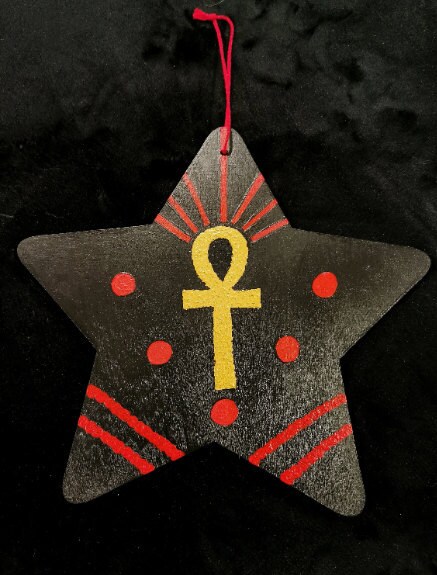The Ankh, often referred to as the "Key of Life," is one of the most recognizable symbols from Ancient Egypt, embodying the concepts of life, immortality, and spiritual power. Its distinctive shape resembles a cross with a loop at the top, and it has intrigued historians, archaeologists, and artists alike for thousands of years. The symbol's significance goes far beyond its visual appeal, as it carries deep spiritual, cultural, and religious meanings.
The Ankh's origins can be traced back to Ancient Egypt, where it was widely used in religious iconography, funerary art, and temple reliefs. The symbol is thought to have emerged around 3,000 BCE, during the Early Dynastic Period of Egypt. It appeared frequently in tombs and on monuments, carried by gods and pharaohs as a symbol of divine protection and eternal life. While the exact origin of the Ankh is not fully understood, it is believed that the symbol may have evolved from an earlier Egyptian hieroglyphic character that represented a sandal strap. Over time, this simple shape was stylized to form the Ankh, with its loop at the top symbolizing the key or opening to the afterlife. The Ankh was often depicted being held by Egyptian gods and goddesses, sometimes touching the nose of the pharaoh to bestow the "breath of life" upon him. In this way, the Ankh became associated not only with life itself but also with divine intervention in the mortal realm.
At the heart of the Ankh's symbolism is the concept of life. Its loop at the top is often interpreted as a representation of the sun, which was the primary source of life in Egyptian cosmology. The vertical line of the Ankh is seen as a representation of the Nile River, the lifeblood of Egypt, while the horizontal line is thought to symbolize the horizon or the earth itself. The combination of these elements makes the Ankh a powerful emblem of the forces that sustain life and the universe. The Ankh's association with immortality is equally significant. In Ancient Egyptian belief, death was not seen as the end of existence but rather as a transition to another realm. The Ankh represented the continuity of life beyond death, and its presence in tombs and on funerary objects signified the hope for eternal life in the afterlife. The Ankh was often depicted in the hands of gods and goddesses, underscoring the divine nature of life and its indestructible qualities. Additionally, the Ankh was believed to be a symbol of power. It was often shown in the hands of deities, pharaohs, and other figures of authority. In Egyptian religion, the Ankh was not just a symbol of life but also a tool of divine rulership. It was thought to have magical properties that could protect the bearer from harm and grant them access to divine knowledge and wisdom. This connection to power is evident in the way the Ankh was used in royal iconography and religious ceremonies.
In Egyptian religious practices, the Ankh played a crucial role. It was closely tied to the gods and goddesses of the Egyptian pantheon, particularly those associated with creation and rebirth. The god Ra, the sun god, was often depicted holding the Ankh to signify his role in giving life to all things. Similarly, the goddess Isis, who was associated with resurrection and healing, was frequently shown holding the Ankh to symbolize her power to restore life. The Ankh also had strong connections to the pharaohs, who were believed to be divine representatives on Earth. In depictions of the pharaoh, the Ankh often appeared as part of royal iconography, signifying the ruler's divine right to lead and their connection to the gods. The pharaoh's possession of the Ankh symbolized his role as the "living god" who had the authority to grant life and order to his people.
In Egyptian art, the Ankh was often represented as part of religious scenes, such as those found in tombs and temples. Gods and goddesses would be shown offering the Ankh to the pharaoh or other important figures, as a gesture of blessing and the bestowal of divine life. It was also common for the Ankh to appear alongside other important symbols, such as the Was scepter (a symbol of power) and the Eye of Horus (a symbol of protection).
While the Ankh originated in Ancient Egypt, its influence spread beyond the borders of Egypt and has remained significant throughout history. In later periods, the symbol was adopted by various cultures and religions, often with new interpretations but retaining its associations with life, death, and immortality.
One of the most notable examples of the Ankh's legacy is its appearance in Christian symbolism. Early Christians, especially in Egypt, used the Ankh as a representation of the cross before the Christian cross became the dominant symbol of the religion. In this context, the Ankh was seen as a symbol of eternal life, echoing Christian beliefs in resurrection and salvation. Some scholars argue that the Ankh may have influenced the design of the Christian cross, which shares similar structural elements.
In modern times, the Ankh has become a popular symbol in various subcultures and spiritual movements. It is often used in jewelry, tattoos, and other forms of artistic expression. Many people today are drawn to the Ankh's associations with life, protection, and spiritual awakening. For example, in New Age spiritual practices, the Ankh is sometimes used as a tool for meditation or as a symbol of the quest for spiritual enlightenment. The Ankh has also found its place in popular culture, appearing in films, television shows, and literature. Its striking design and powerful symbolism make it a compelling visual element, often associated with themes of immortality, divine power, and the supernatural. From ancient Egypt to modern pop culture, the Ankh has proven to be a symbol with enduring relevance and universal appeal.


